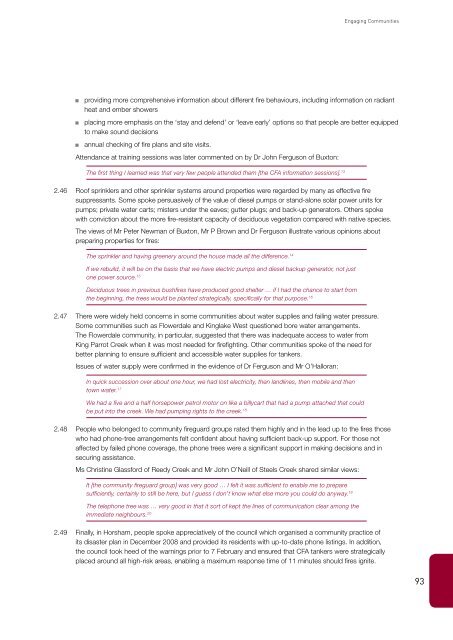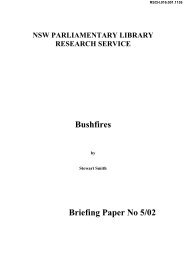engaging communities - 2009 Victorian Bushfires Royal Commission
engaging communities - 2009 Victorian Bushfires Royal Commission
engaging communities - 2009 Victorian Bushfires Royal Commission
Create successful ePaper yourself
Turn your PDF publications into a flip-book with our unique Google optimized e-Paper software.
Engaging Communities<br />
■■<br />
■■<br />
■■<br />
providing more comprehensive information about different fire behaviours, including information on radiant<br />
heat and ember showers<br />
placing more emphasis on the ‘stay and defend’ or ‘leave early’ options so that people are better equipped<br />
to make sound decisions<br />
annual checking of fire plans and site visits.<br />
Attendance at training sessions was later commented on by Dr John Ferguson of Buxton:<br />
The first thing I learned was that very few people attended them [the CFA information sessions]. 13<br />
2.46<br />
Roof sprinklers and other sprinkler systems around properties were regarded by many as effective fire<br />
suppressants. Some spoke persuasively of the value of diesel pumps or stand-alone solar power units for<br />
pumps; private water carts; misters under the eaves; gutter plugs; and back-up generators. Others spoke<br />
with conviction about the more fire-resistant capacity of deciduous vegetation compared with native species.<br />
The views of Mr Peter Newman of Buxton, Mr P Brown and Dr Ferguson illustrate various opinions about<br />
preparing properties for fires:<br />
The sprinkler and having greenery around the house made all the difference. 14<br />
If we rebuild, it will be on the basis that we have electric pumps and diesel backup generator, not just<br />
one power source. 15<br />
Deciduous trees in previous bushfires have produced good shelter … if I had the chance to start from<br />
the beginning, the trees would be planted strategically, specifically for that purpose. 16<br />
2.47<br />
There were widely held concerns in some <strong>communities</strong> about water supplies and failing water pressure.<br />
Some <strong>communities</strong> such as Flowerdale and Kinglake West questioned bore water arrangements.<br />
The Flowerdale community, in particular, suggested that there was inadequate access to water from<br />
King Parrot Creek when it was most needed for firefighting. Other <strong>communities</strong> spoke of the need for<br />
better planning to ensure sufficient and accessible water supplies for tankers.<br />
Issues of water supply were confirmed in the evidence of Dr Ferguson and Mr O’Halloran:<br />
In quick succession over about one hour, we had lost electricity, then landlines, then mobile and then<br />
town water. 17<br />
We had a five and a half horsepower petrol motor on like a billycart that had a pump attached that could<br />
be put into the creek. We had pumping rights to the creek. 18<br />
2.48<br />
People who belonged to community fireguard groups rated them highly and in the lead up to the fires those<br />
who had phone-tree arrangements felt confident about having sufficient back-up support. For those not<br />
affected by failed phone coverage, the phone trees were a significant support in making decisions and in<br />
securing assistance.<br />
Ms Christine Glassford of Reedy Creek and Mr John O’Neill of Steels Creek shared similar views:<br />
It [the community fireguard group] was very good … I felt it was sufficient to enable me to prepare<br />
sufficiently, certainly to still be here, but I guess I don’t know what else more you could do anyway. 19<br />
The telephone tree was … very good in that it sort of kept the lines of communication clear among the<br />
immediate neighbours. 20<br />
2.49<br />
Finally, in Horsham, people spoke appreciatively of the council which organised a community practice of<br />
its disaster plan in December 2008 and provided its residents with up-to-date phone listings. In addition,<br />
the council took heed of the warnings prior to 7 February and ensured that CFA tankers were strategically<br />
placed around all high-risk areas, enabling a maximum response time of 11 minutes should fires ignite.<br />
93
















